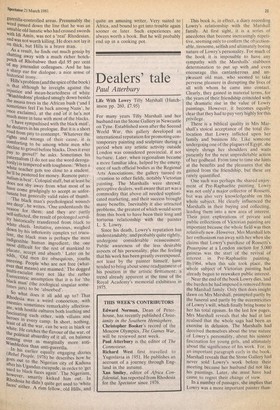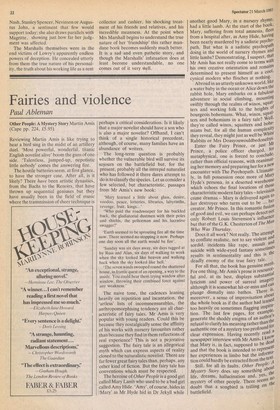Dealers' tale
Paul Atterbury
Life With Lowry Tilly Marshall (Hutchinson pp. 260, £7.95) For many years Tilly Marshall and her husband ran the Stone Gallery in Newcastle on Tyne. Established soon after the Second World War, this gallery developed an international reputation for promoting contemporary painting and sculpture 'during a period when any artistic activity outside London was considered provincial, if not barbaric. Later, when regionalism became a more familiar idea, helped by the emergence of such official bodies as the Regional Arts Associations, the gallery turned its :mention to other fields, notably Victorian painting. The Marshal's were shrewd, perceptive dealers, well aware that art was a commodity that above all needed sophisticated marketing, and their success brought many benefits. Inevitably it also attracted problems, the greatest of which would seem from this book to have been their long and tortuous relationship with the painter L. S. Lowry.
Since his death, Lowry's reputation has understandably, and probably quite rightly, undergone considerable reassessment. Public awareness of the less desirable aspects of his personality, plus the feeling that his work has been greatly overexposed, not least by the painter himself, have tended to bring about some readjustment of his position in the artistic firmament; a trend already apparent at the time of the Royal Academy's memorial exhibition in 1975. This book is, in effect, a diary recording Lowry's relationship with the Marshall family. At first sight, it is a series of anecdotes that become increasingly repetitive, seeming only to confirm the objectionable, tiresome, selfish and ultimately boring nature of Lowry's personality. For much of the book it is impossible to have any sympathy with the M.arshalls' stubborn determination to put up with and even encourage this cantankerous and unpkasant old man, who seemed to take perverse pleasure in disrupting the lives of all with whom he came into contact. Clearly, they gained in material terms, for the years of their friendship coincided with the dramatic rise in the value of Lowry paintings. However, it becomes equally clear that they had to pay very highly for this privilege.
There is a biblical quality in Mrs Marshall's stoical acceptance of the total dis location that Lowry inflicted upon her family and business life. Like someone undergoing one of the plagues of Egypt, she simply shrugs her shoulders and waits patiently for the next unpredictable action of her godhead. From time to time she hints at the benefits and the pleasures that she gained from the friendship, but these are rarely quantified. One such was .perhaps the shared enjoyment of Pre-Raphaelite painting. Lowry was not only a major collector of Rossetti, hut was also very knowledgeable on this whole subject. He clearly influenced the Marshal's in their buying and collecting, leading them into a new area of interest. Their joint explorations of private and public collections of Victorian painting are important because the whole field was then relatively new. However, Mrs Marshall lets her enthusiasm run away with her when she claims that Lowry's purchase of Rossetti's Proserpine at a London auction for 5,000 guineas was the start of the revival of interest in Pre-Raphaelite painting. By1964, when this sale took place, the whole subject of Victorian painting had already begun to reawaken public interest. Near the end of the'book Lowry dies. land the burden he had imposed is removed from the Marshall family. Only then does insight dawn on Mrs Marshall, prompted partly by the funeral and partly by the eccentricities of Lowry's will, which finally bring home to her his total egoism. In the last few pages, Mrs Marshall reveals that she had at last realised that the whole saga had been an exercise in delusion. The Marshalls had deceived themselves about the true nature of Lowry's personality, about his sinister fascination for young girls, and ultimately about the significance of his work. For, in an important paragraph early in the book, Marshall reveals that the Stone Gallery had never sold Lowry's work before their meeting because her husband did not like his paintings. Later, she must have had cause. to regret their change of view. In a number of passages, she implies that Lowry was a more important painter than Nash, Stanley Spencer, Nevinson or Augustus John, a sentiment that few would support today; she also draws parallels with Magritte, showing just how far her judg ment was affected. , The MarshaIls themselves were in the ' end victims of Lowry's apparently endless powers of deception. He concealed utterly from them the true nature of his personality, the truth about his working life as a rent collector and cashier, his shocking treatment of his friends and relatives, and his incredible meanness. At the point when Mrs Marshall begins to understand the true nature of her 'friendship' this rather mundane book becomes suddenly much better. It is a sad and even pathetic story, and though the Marshal's' infatuation does at least become understandable, no one comes out of it very well.







































 Previous page
Previous page